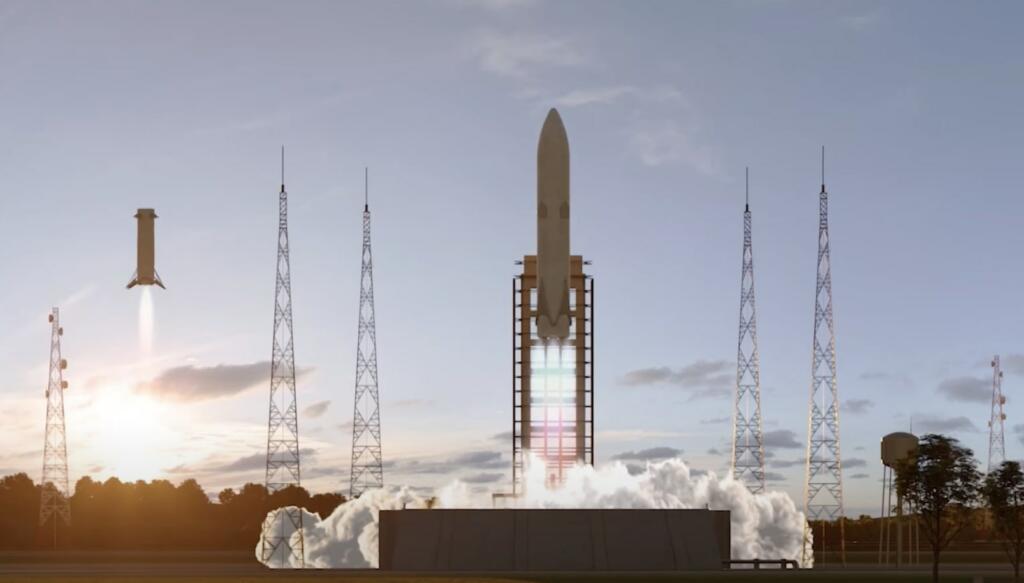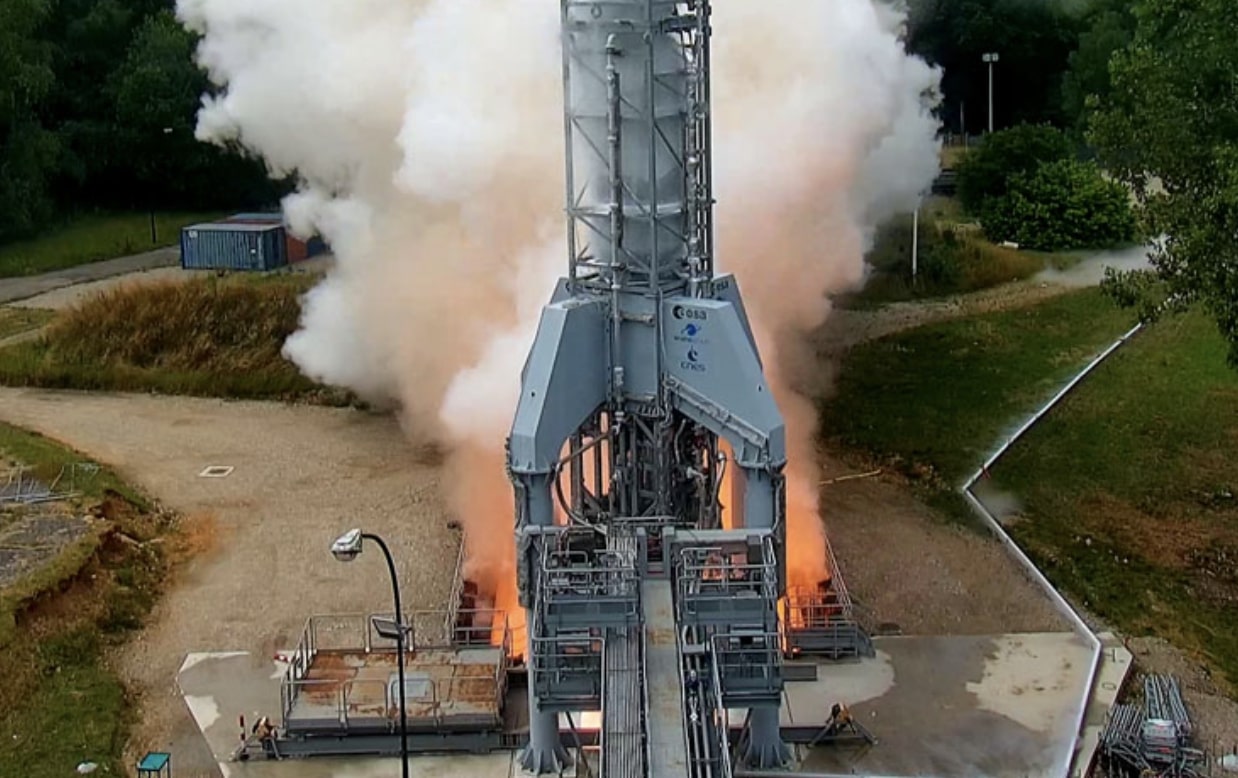ArianeGroup has successfully carried out the first ignition campaign of the reusable Prometheus® engine on the reusable Themis rocket core stage demonstrator – a key step in providing Europe with the essential technological building blocks for future reusable launchers. This test of a complete rocket stage running on liquid oxygen and bio-methane is a first in Europe. Prometheus has 100 tons of thrust. SpaceX Raptor 2 engine has 269 tons of thrust. The SpaceX Merlin engines are in the 70-100 tons of thrust range.
The Prometheus engine is planned to have the following features:
Methane–oxygen propellant.
Extensive use of metal 3D printing (up to 50% of the engine).
Open gas-generator cycle.
980 kN of thrust (~100 tonnes), variable from 30% to 110% thrust.
100 bar (10,000 kPa) chamber pressure.
360 s specific impulse (Isp).
Reusable 3 to 5 times.
Around 1 million euros production cost.
SpaceX is targeting $250,000 cost for its Raptor engine.
Ariane had previously had a timetable where there would be a full flight test of the Themis rocket four years after the first engine test firing.
The estimated program timeline, as of December 2020, was as follows:
2020: Basic stage testing, composed of tank filling and ground support equipment tests.
2021: Prometheus engine testing [2 years late]
2022: Low-altitude hop tests (short flights up from and down to the launch site)
2023: Initial flight test
2023–2024: Loop tests (repeated flights of the reusable demonstration vehicle)
2025: Full flight envelope test
The first flight test might be in 2027.
This would get Ariane up to the level of the SpaceX Falcon 9 with a reusable first stage. SpaceX successfully landed its first Falcon 9 stage in 2015. SpaceX had first stage landing tests in 2012-2014.

On June 22, 2023 at its Vernon site in France ArianeGroup successfully carried out the final test in the ignition campaign of the reusable Prometheus® engine on the reusable Themis rocket stage demonstrator, which is being used as the test bench. The engine performed a 12-second burn.
It will provide lower thrust than the Vulcain 2.1, which delivers 130 tonnes in a vacuum, the methane fuel component is six times denser than hydrogen and will enable more ‘compact’ rocket stages that are easier to recover.
The re-ignitable baseline design of Prometheus makes it suitable for core, booster and upper-stage applications. It could also serve as a precursor for Vulcain 2.1 improvements.
According to CNES, Prometheus will offer significant economies by reducing production costs tenfold with respect to the Vulcain engine – which has a unit cost of one million euros – thanks to new architecture, extensive use of 3D printing and a production rate of 50 engines per year.
Prometheus engine testing is scheduled to continue at the end of this year at the German Aerospace Center (DLR) test bench in Lampoldshausen, Germany.
Later in the testing schedule a combined Prometheus engine and Themis stage will attempt a series of ‘hop-tests’, lifting a few meters above the ground to check flight and landing capability.
Prometheus®, developed by ArianeGroup with its European partners, is a new-generation, reusable, high-thrust (100 ton) engine which runs on liquid oxygen (LOX) and liquid methane (LCH4). This test campaign consisted of firing the Prometheus® engine on Themis, as the test bed. The successful ignition of Prometheus® is a first in Europe for this class of engine. For this campaign, ArianeGroup used bio-methane fuel, in line with the company’s aim of trail-blazing environmental innovation.
Carrying out these tests on Prometheus® and Themis together on the PF20 test bench at Vernon will allow characterization of the operating behavior of both engine and stage in an extended mission profile. Prometheus® engine testing will continue at the end of 2023 on the German Aerospace Center (DLR) test bench at Lampoldshausen, Germany.
ArianeGroup will soon be setting up a Prometheus® Users Club, along the lines of the Ariane 6 Users Club. This step marks the beginning of marketing Prometheus® to all interested European parties.
Themis is a reusable rocket stage demonstrator for which ArianeGroup is the lead contractor. Two years after the contract for the initial phase of Themis was signed with ESA, this first combined test campaign with the Prometheus® engine is a key step in the progress of the project. It paves the way for the next test campaign, to be carried out at Kiruna in Sweden, under the European Union’s Horizon Europe program (SALTO project).

Brian Wang is a Futurist Thought Leader and a popular Science blogger with 1 million readers per month. His blog Nextbigfuture.com is ranked #1 Science News Blog. It covers many disruptive technology and trends including Space, Robotics, Artificial Intelligence, Medicine, Anti-aging Biotechnology, and Nanotechnology.
Known for identifying cutting edge technologies, he is currently a Co-Founder of a startup and fundraiser for high potential early-stage companies. He is the Head of Research for Allocations for deep technology investments and an Angel Investor at Space Angels.
A frequent speaker at corporations, he has been a TEDx speaker, a Singularity University speaker and guest at numerous interviews for radio and podcasts. He is open to public speaking and advising engagements.


“Bio-methane”? How do they imagine the methane coming out of holes in the ground originated, anyway? Might as well call charcoal “bio-carbon” thinking you’re distinguishing it from coal somehow.
When they say “bio methane”, they don’t mean methane from living things, they mean methane from currently-living things.
The idea is that if you capture methane from currently-living things and burn it, then there is less greenhouse effects than if you didnt capture it at all.
That’s different from methane you dig up from the ground, because that methane would have stayed in the ground if you had done nothing.
At least, that’s the theory.
Arianespace and France should make a deal with SpaceX to launch Starships from Kuru in French Guiana. They should also buy/lease 2 or 3 super heavy boosters and build an expandable second stage (LH2/LO2) for extra large payloads (200-250 mT).
So, for now, ArianeSpace is literally ten years behind SpaceX… Better late than never, I suppose.
The Euro French rocket was great when it lifted Webb.